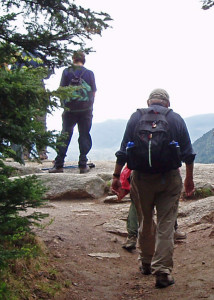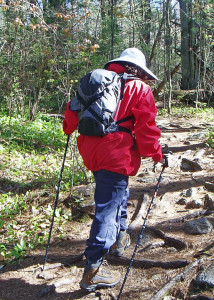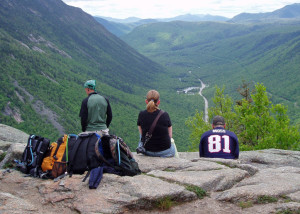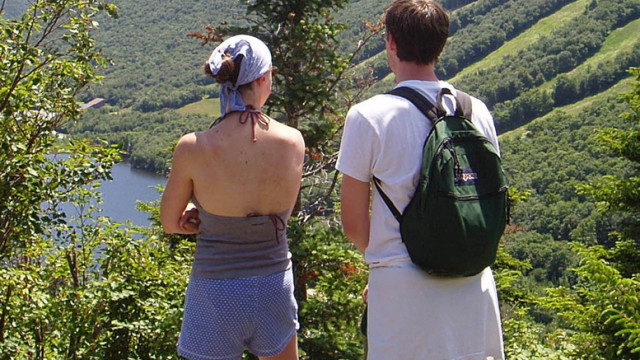
When spring arrives, so do more opportunities for quick, fun outdoor adventures. The days are longer, you don’t need quite as much gear to stay safe and comfortable, and it’s just easier (for some people) to get motivated to get yourself out in the sunshine and fresh air.
If you want to spend more time outdoors, the best way I know to accomplish that is to follow the old Boy Scout Motto and “Be Prepared.” Whenever you leave the road, even for a short hike, you immediately become personally responsible for your own safety and comfort until you return. Too many people today think that nothing will ever go wrong. And since they always have a cell phone with them, they assume that’s all the backup they need.
Wrong. Cell phones are wonderful, at times, and they’ve saved many stranded hikers. But batteries can die, signals vary, and you can’t count on them!
Instead, I encourage you to get in the habit of keeping a small daypack stowed in your car. Have it filled with your hiking essentials (see below), plus sturdy comfortable, well-broken-in walking shoes or light hiking boots, a pair of good wool hiking socks, and, maybe, a pair of trekking poles. That way, you are ready if you suddenly find yourself with a few minutes to spare and an interesting place to stroll away from the road. Once you start looking, you’ll be amazed at how many wonderful adventures you can find nearby.

Picking a good daypack is easy. There are, literally, hundreds on the market. Just make sure it’s sturdy, fits you and will comfortably carry what you need. Personally, I’d rather have a pack that’s too big than even a little too small. The problem with too small a pack is that you might be tempted to leave behind something essential. Functional daypacks for adults start at about 1,200 cubic inches (roughly 20 liters). For most folks something between 1,400 and 1,800 cu in (24 to 30 liters) is probably about right. My friends Edie and Warner Shedd have started seeking out adventures near their Vermont home as a way to get more exercise and have more fun. They recently got a couple of daypacks from LL Bean, a “Day Trekker” (1800 cu. in) for him, a “Bigelow Women’s” (1,700 cu. in.) for her. Very nice packs for the money. I’m always trying new daypacks including a new “Salish” (2,100 cu. in) from Jansport. So far, it neatly stows everything I need to carry (more on that in a moment) and is breaking in nicely.

Choosing a daypack is more than just getting the right size. There’s general shape. Personally, taller, narrower packs seem to carry less obtrusively for me than shorter, fatter ones.
Any hiking Go Pack should have, at least, contoured shoulder straps, preferably with a sternum strap to secure across your chest. Either a frame or a stiff pad against your back and a real hip belt that wraps and transfers at least some of the weight onto your hipbones rather than a simple waist strap contribute to comfort. I personally like a large main pocket, a top pouch for small stuff, and an easy-to-reach outside pocket or two. Many if not most daypacks these days come with a sleeve for a hydration bladder—a useful feature. I also like a bungee cord, or straps and lash points on the outside in case you need to carry something bulky.
The whole point of a Go Pack, however, is to keep it handy and filled with what you need to safely and comfortably enjoy some free time outdoors.
What Goes In Your Go Pack?
Whenever you leave the road, someone in your group (even if you are a group of one) should carry a basic Emergency Kit, which should include, at a minimum: a sharp knife, matches in waterproof matchsafe, a butane lighter, firestarters, spare compass, LED flashlight with spare battery, whistle, 15 feet of heavy-duty waterproof (duct) tape, 30 feet of nylon parachute cord, 12 large twist ties, cable ties or both, 4 large safety pins, needle and thread, and two 55 gal. contractor trash bags for emergency shelter. My kit fits in a bright orange (harder to lose) 4” x 4” x 8” zippered nylon case which can ride on my belt, and weighs just under a pound–not bad for something that could save your life.
In addition, everyone should carry water in a bottle or hydration bladder, map and compass (even a rough sketch of the area with North marked is better than no map at all), insect repellent, sunscreen, a hat and sunglasses. Food is optional—most of us carry enough extra fuel around our waistlines to last for a long time if we have water and shelter.
The real reason to carry a backpack is so you can carry raingear—no matter how warm and dry the weather forecast! Also take a shirt or lightweight fleece and long pants if you are hiking in shorts and a t-shirt. The weather can always turn bad.
Fun Extras For Your Go Pack
Having a daypack lets you carry a few fun extras you might otherwise leave at home.
Be sure to bring along a camera. Most of the photos which accompany this column are shot with a pocket-sized point-and-shoot. I get the photos because the camera is there and ready. If you get out in the woods a lot, think about getting a water resistant camera like the Olympus Stylus series; you can use those cameras when you otherwise might not want to take a camera out of your pack.
Binoculars are always welcome, affording you close-up views of birds and animals you might only glimpse otherwise. There are a lot of truly excellent small pairs available; if you don’t have any yet, you might want to consider something in the 8x range. Plenty of magnification for most purposes, and relatively easy to hold steady…higher magnifications tend to be hard to hold still.
I hardly ever go anywhere without one or more guidebooks to the birds, wildflower, trees, or mushrooms I might see along the way. Without a daypack, you might be tempted to leave these in the car and miss out on a lot of fun. Put them in a ziplock bag inside your pack, just in case you get caught in a downpour!



One beautiful morning recently while visiting our family cabin in the White Mountains of New Hampshire, my daughter and I decided to take a short hike on one of the nearby trails. We started out right after breakfast on the Hubbard Brook Trail in Warren. At about midpoint, we decided to hike the entire trail, figuring that it would come out near the “downtown” area of Warren. Mind you, we were not prepared with food, drink, map or compass. At the end of the 3-mile trail, we set out ton a logging road, figuring we would come to a town road immediately. After hiking another hour, we met a USFS ranger, who advised us that we had another 3 miles of logging road, and would end up in Thornton (45 minutes by car from Warren), MILES from where we expected to be. The easiest way back? The way we came! The trails were reasonably dry, we saw many beavers and had a wonderful time – but I thought of you and your admonitions to prepare well for each and every adventure outdoors.
Gary,
Thanks for sharing this! I’m really, really glad your little “adventure” ended without any mishaps. Happy endings are always good–especially when we can all learn a life lesson from them! Looking on a map I can see exactly what happened to you and your daughter, and how you could have gone even “wronger” if you’d made another bad choice along your route. I wish everyone could get a little “reminder” like this and take the lesson to heart before they got into real trouble.